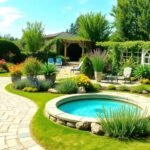The truth about artificial grass that nobody wants to admit

Bienvenido a este artículo sobre The truth about artificial grass that nobody wants to admit
The use of artificial grass has become increasingly popular in recent years, offering an evergreen look with minimal maintenance. However, amidst the convenience and aesthetic allure, there are underlying realities that often go unspoken. In this article, we delve into the truths about artificial grass, shedding light on aspects that manufacturers and sellers might downplay. From environmental concerns to long-term costs, we uncover what you should know before laying down that synthetic turf. Join us as we explore the often-ignored implications of choosing artificial grass for your home or public space.
Why you shouldn't use fake grass?
Discover the hidden consequences of opting for a synthetic lawn that the industry doesn't want you to know! While the idea of a no-maintenance, evergreen turf may sound tempting, there's a side to it that might change your mind forever.
Firstly, brace yourself for the environmental impact. Synthetic grass is often touted as a water-saving miracle, but did you know that it's actually made of plastic? Yes, the very material we're desperately trying to reduce in our lives. This means it's not biodegradable and will one day end up in landfills, taking hundreds of years to break down.
Moreover, if you're an animal lover, this next point will make you think twice. Artificial turf can be a hazard to wildlife. Creatures big and small can mistake the tiny plastic blades for food, leading to harmful ingestion that can be fatal.
And for those who love the earth beneath their feet, consider the impact on soil health. Fake grass essentially seals off the ground, preventing it from breathing, absorbing water, and supporting the intricate ecosystems that real grass lawns foster.
Think it's safer for your kids and pets? Think again. The crumb rubber infill used in many synthetic lawns is a cocktail of toxic chemicals that can be harmful upon exposure. The potential risks are still being studied, but do you really want to gamble with health?
Finally, imagine a sweltering summer day. Unlike natural grass, which cools the environment, fake grass turns into a heat island, raising temperatures unnaturally. Your dream of a perfect lawn could turn into a scorching nightmare.
Stay tuned as we unveil the alternatives that not only give you a gorgeous green space but also contribute to a healthier planet. Keep your eyes peeled for solutions that blend beauty, responsibility, and sustainability. Don't let the lure of convenience rob you of the joy of a living, breathing garden. Your choice matters more than you think.
Why are people getting rid of artificial grass?
You won't believe the shift happening in backyards across the globe. Homeowners are uprooting their artificial turf and the reasons will surprise you. This isn't just about aesthetics; it's a movement driven by environmental concerns and health implications that are pushing people to reconsider their faux-green spaces.
Firstly, the toxic chemicals used in the manufacturing process of synthetic grass have become a major cause for alarm. Studies reveal that these materials can leach into the ground, potentially contaminating water sources. Imagine playing with your kids or pets on a surface that could be harming their health.
But the alarming facts don't stop there. The promise of low maintenance is quickly overshadowed by the reality of non-biodegradable materials cluttering our landfills. The very essence of a sustainable and eco-friendly lifestyle is being called into question as the long-term waste management issues surface.
And don't get started on the urban heat island effect. These synthetic lawns absorb and radiate heat, contributing to higher temperatures in your garden oasis. On sweltering summer days, the last thing you want is your yard radiating heat like a mini desert.
Furthermore, the financial implications are not to be underestimated. The initial savings on water and lawn care are enticing but consider the replacement costs. Artificial grass doesn't last forever, and when it comes to changing it, the price can be steep.
The revolution doesn't stop there:
1. Wildlife Impact: Nature enthusiasts are dismayed at the loss of biodiversity. Real grass supports an entire ecosystem – from soil microbes to birds.
2. Authenticity: There's a renewed longing for the genuine connection with nature that synthetic alternatives simply can't replicate.
3. Community Pressure: Social norms are pivoting as neighbors and councils promote natural landscaping, pressuring residents to follow suit for the greater good.
The tide is turning, and the choice is clear. As people are making the switch back to natural grass, one must wonder, are you ready to be part of this green revolution? The health of our planet and future generations depends on decisions like these. Don't let this opportunity to make a positive change slip through your fingers. The grass is indeed greener on the other side, and it's time to find out why.
What is the problem with artificial grass?
Imagine strolling through a lush, evergreen lawn that requires virtually no maintenance. At first glance, artificial grass seems like the perfect solution for a picturesque yard year-round. But as you peel back the layers of this convenient ground cover, a tapestry of issues begins to unfold, and you can't help but wonder if the trade-offs might be too great.
Firstly, the environmental impact is staggering. These synthetic fields are often made from materials like rubber and plastics that don't biodegrade. Picture this: pieces of worn-out turf languishing in landfills for centuries, leaking microplastics into our ecosystems.
Then there's the heat. On a sunny day, an expanse of artificial turf can turn into a sizzling surface, reaching temperatures high enough to make you second-guess that barefoot walk in the park. This not only affects human comfort but can also harm local wildlife seeking refuge in what looks like a welcoming habitat.
And let's not overlook the potential health concerns. Crumb rubber infill, a common component in synthetic turf, has raised alarms for its possible link to serious health issues. The very ground athletes and children play on could be a hidden source of toxic exposure.
Maintenance isn't as straightforward as it seems, either. Sure, you won't be mowing or watering, but artificial lawns require their own kind of upkeep. Regular cleaning, chemical treatments to disinfect, and even eventual replacement add to the long-term cost and effort.
Curious about the economic implications or the social factors at play? What more could we be sacrificing for the sake of convenience? The answers are compelling, and they hint at a larger narrative that challenges the way we approach modern landscaping.
The reality of artificial grass is nuanced and multi-faceted, with each revelation pulling you deeper into a conversation that is crucial for our planet's future. The implications go beyond aesthetics and into the realm of responsibility. Stay tuned, because understanding the full picture is a journey worth taking.
Why do people hate fake grass?
The burning question of why synthetic lawns stir up such strong emotions remains a curious topic for many. The answers are more intricate and profound than one might initially surmise, and they hint at underlying values and beliefs that shape our views on nature and technology.
Firstly, the environmental impact of artificial turf is a major source of contention. While it requires no watering, fake grass is not biodegradable, leading to concerns about its contribution to landfill waste at the end of its life cycle. Moreover, the materials used in its production are often non-renewable and the process itself can be quite energy-intensive.
Another point of dispute lies in the health and safety concerns. Reports have surfaced suggesting that the rubber infill, a component frequently used in fake grass to provide cushioning, may contain harmful chemicals. The debate intensifies with cases of overheating surfaces, which could potentially cause burns and discomfort, especially in areas with high temperatures.
Furthermore, there's an undeniable aesthetic and sensory discrepancy between natural and artificial grass. For many, the softness underfoot, the smell after a rain, and the sound of wind through real blades are irreplaceable experiences that artificial turf simply cannot replicate. This sensory gap can lead to a lack of satisfaction for individuals who value authentic natural beauty.
In the same vein, artificial grass lacks the ecological benefits of its natural counterpart. It does not support local wildlife, such as bees and butterflies, which are crucial for pollination and maintaining biodiversity.
The discussion wouldn't be complete without addressing the psychological aspect. There's a sense of accomplishment and connection to the earth that comes with tending to a real lawn. The growth, maintenance, and even the challenges of dealing with natural elements can foster a feeling of pride and well-being that fake grass doesn't offer.
The intricacies of this debate are boundless, and we've merely scratched the surface. As you ponder the complexities of the fake grass quandary, one thing becomes clear: the roots of this aversion run deep, touching upon our intrinsic relationship with the natural world. The question now beckons: what side of the fence are you on? Dive deeper into this green conundrum and unearth the layers of this modern-day conflict between the synthetic and the organic.
Why artificial grass is bad for the environment
Imagine stepping out into a verdant, lush garden that requires no watering, no mowing, and zero maintenance. The allure of artificial grass is undeniable in our fast-paced world. But lurking beneath the surface of this convenient alternative to natural turf lies a trove of environmental pitfalls that could be silently degrading our planet's health.
Unveiling the truth, we delve into the synthetic reality where manicured perfection comes at a hidden cost. The fibers that mimic the softness and greenery of real grass are products of petroleum, a non-renewable resource, and the production process is riddled with carbon emissions. Each square foot of this man-made turf represents a piece of nature displaced, a habitat potentially destroyed, or a chance for soil regeneration squandered.
- Firstly, consider the microplastic pollution. These tiny fragments break away over time, infiltrating our soil and waterways, and ultimately entering the food chain.
- Secondly, the issue of heat absorption is alarming. Unlike its living counterpart, artificial turf can reach scorching temperatures, contributing to urban heat islands and discomfort for local fauna.
- Thirdly, there's the end-of-life problem. The lifespan of synthetic grass is limited, and when it comes time to dispose of it, the options are grim. Landfills become the final resting place for these non-biodegradable carpets, where they will lie for centuries.
But wait, there's more. The layers beneath the artificial blades are seldom discussed, yet they are integral to understanding the full environmental impact. What secrets do the crumb rubber infill hold? What about the chemical cocktails used to keep these lawns pristine?
As you stand on the precipice of making a choice for your home or community, the temptation of low maintenance lawns is compelling. But before you take that leap, pause and consider the future we are shaping. Are you ready to uncover the dark side of the green facade?
To truly grasp the scope of this environmental quandary and make an informed decision, one must dig deeper than the surface. The journey into the heart of the matter is fraught with revelations that could change the way we see our own backyards. Stay tuned, because what you discover next may surprise you and inspire a movement towards a more sustainable tomorrow.
Consejo final: Si estás considerando instalar césped artificial, es crucial realizar una investigación exhaustiva. Comprende tanto las ventajas como los inconvenientes, como el costo inicial, el mantenimiento requerido y el impacto ambiental. Sopesa estos factores en función de tus necesidades específicas y valores personales para tomar una decisión informada. Que este nuevo conocimiento te guíe hacia una elección satisfactoria para tu espacio al aire libre. Que tengas éxito en tu proyecto.
 Do you really need flowers for a beautiful yard?
Do you really need flowers for a beautiful yard? This small upgrade can double your yard’s visual impact
This small upgrade can double your yard’s visual impact What I learned after spending $10,000 on landscaping
What I learned after spending $10,000 on landscaping Why this stone is the new superstar in outdoor design
Why this stone is the new superstar in outdoor design This landscaping trend is so new it doesn’t even have a name yet
This landscaping trend is so new it doesn’t even have a name yetIf you want to know more about similar articles like The truth about artificial grass that nobody wants to admit you can visit category Landscaping.
Deja una respuesta